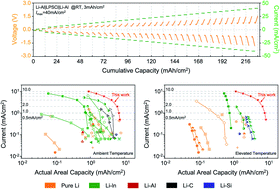Li alloy anodes for high-rate and high-areal-capacity solid-state batteries†
Abstract
The serious challenges in utilizing Li metal anodes with solid electrolytes (SEs) have stimulated the research on developing alternative anodes for solid-state batteries (SSBs). Alloy-based anodes in SSBs have been gaining great interest recently due to their high capacities. Compared with Li metal, the slightly higher voltages of alloy anodes can help to improve the interfacial stability with SEs, but using alloy anodes cannot perfectly prevent the dendrite formation. Besides, a detailed understanding of the dendrite suppression capability of alloy anodes is still missing. Here we aim to provide some insights by evaluating the dendrite suppression capability of common Li alloys, including Li–Zn, Li–Si, Li–Sn, and Li–Al. It is found that even for alloy anodes with medium lithium contents and a three-dimensional alloy/SE composite structure, soft shorting of SSBs still occurred for some alloys. Among all the alloy anodes studied in this work, Li–Al exhibited the highest capability of suppressing dendrite formation. No soft shorting can be observed when symmetric cells using Li–Al anodes were tested at a high current density of 40 mA cm−2 with a capacity of 3 mA h cm−2. The excellent dendrite suppression capability of Li–Al alloy was also demonstrated in solid-state lithium–sulfur batteries with a high cathode loading of 10 mA h cm−2. The results indicate that Li–Al alloy can be used as a promising anode for high-rate and high-areal-capacity SSBs. The differences in the dendrite suppression of various alloys also imply that the mechanical properties of alloys may play a very important role in governing dendrite formation on these anodes.



 Please wait while we load your content...
Please wait while we load your content...